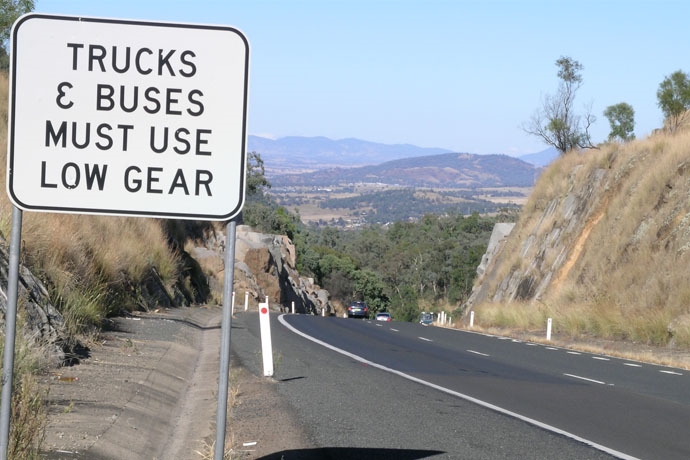
Downhill driving can be an uphill battle.
Descending roads like Toowoomba range QLD or Mt Ousley in NSW can be treacherous on a clear day, so it pays to apply common sense and obey Australian Road Rule 108 to protect yourself and other driver’s around you. But, what is Rule 108?
Rule 108 – A brief history
You’ve probably seen the ‘Trucks & Buses Must Use Low Gear’ sign when descending a large downhill, but why? This rule is nation-wide and situated on a number of large descents, designed specifically to reduce serious accidents to you and other motorists.
Before this rule was applied, trucks had limited auxiliary retardation devices and drivers would descend hills too quickly with limited ability to slow the vehicle. Using both their service brakes as well as down shifting on descents, drivers could inadvertently cause the vehicle brakes to increase in temperature, which resulted in dangerous brake fade. Some pretty awful and serious consequences of drivers losing control of their vehicle were common news and something had to be done.
What is Rule 108? Why you should pay attention?
Rule 108 – ‘If the driver of a truck or bus is driving on a length of road to which a trucks and buses low gear sign applies, the driver must drive the truck or bus in a gear that is low enough to limit the speed or bus without the use of the primary brake.’
By law, all truck and bus drivers driving on Australian roads marked with a 'trucks & buses must use low gear' sign must obey this law. This applies to all operators of trucks above 4.5 tonne GVM. (This method is highly recommended for anyone holding a car drivers licence who is driving a truck under 4.5 tonne GVM.)
So… you must drive in a gear that is low enough to limit the speed of your vehicle without using the foot brake. Using an appropriate gear for your truck on the descent ensures the speed of the truck remains constant and under that is indicated. This rule aims to ensure you use the trucks engine retardation to get you down the descent safely.
To reduce accidents, drivers must always take safety seriously by using skill and experience to choose a safe entry to a long slope, especially when carrying a large load, preventing accidents or rollovers.
So, what speed do I descend?
The recommendation is to follow the road signs that apply for the descent and travel in the indicated lane only. Keep an eye out and never go over the limit, safety should be your priority.
Travelling at this speed will allow the full engine and/or exhaust brake retardation to be undertaken by your truck.
Keeping engine speed high will create a higher retardation effect on your truck but avoid allowing the rpm to increase above your maximum engine speed, as it may cause serious engine damage (i.e. going into the red zone). Also avoid prolonged brake applications and holding your foot on the brake, as this has been proven to increase brake temperature, meaning potential brake fade and accelerated wear.
If your engine shows any sign of gaining speed suddenly, use the service brakes to maintain vehicle control. Avoid downshifting on descents unless you are in full control of the vehicle and this should only to be done at very slow speeds.
The right brake for the job
There are various truck brakes and terminology. An exhaust brake, engine brake or retarder can all give your service brakes the extra support they need to keep you safe on steep descents.
Service Brakes – These are your primary brakes on the wheels and controlled by your foot pedal.
Exhaust Brake – This system essentially closes the exhaust system and retards the engine resulting in driveline retardation. This system is controlled by a cab mounted switch.
Engine Brake – Also known as an engine retarder, this system basically converts your engine into a compressor. Doing so generates retardation on the driveline. This is controlled by a cab mounted switch.
Retarder – Generally mounted on the output of the transmission providing braking torque to the driveline. A retarder can be hydraulic or electric and controlled by a cab mounted switch.
Brake Fade – A common term used for loss of brake efficiency. This is caused by extreme brake temperature and the friction material of the brake lining breaks down consequently reducing its ability to slow the disc or drum and thus inability to slow the vehicle.
Legalities of descending hills
Reckless driving and speeding have legal consequences around the country and are outlined on the NHVR website, but states implement specific laws and costly fines directly related to hills and steep descents. For example, in NSW, disobeying trucks and buses low gear sign results in a $330 fine and 3 demerit points. Most states impose similar fines and rules, so take care.
Safety first
The number one thing to remember here is always safety first. Driving a truck on a large descent can be extremely dangerous, so always take precautions, follow the speed limit, commence descend in a gear that is low enough to limit your speed and avoid prolonged brake application. You don’t want a get a fine, you definitely don’t want to damage your beloved truck and the last thing you want to do is injure yourself or others.